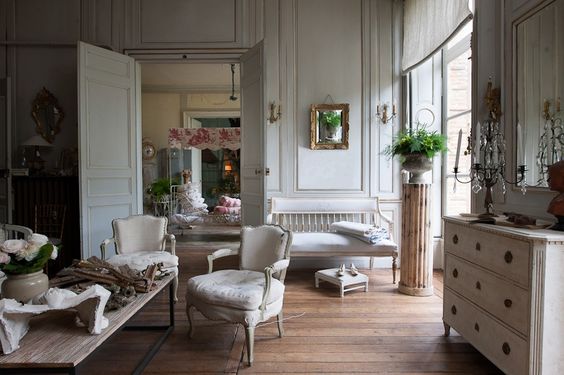A question I am asked frequently pertaining to French arm chairs is "what is the difference between a fauteuil and a bergère. While people often use the terms interchangeably, these are indeed two different chairs. This blog post is designed to show you the difference, and hopefully convince you how incorporating either of them into you home will provide instant polish and sophistication. This post will be devoted to the fauteuil, with a follow up in a few days spotlighting the bergère. First let's learn how to pronounce it.
The fauteuil (foe-toy) is an upholstered armchair with open sides and a primarily exposed wooden frame that is often gilded or otherwise painted. The fact that it has open sides distinguishes it from the bergère which is totally enclosed. It is typically upholstered on the seat, the seat back, and on the arms (manchettes), with carved decoration on the arms, legs, seat edge, and around the frame of the back. The style is never fussy, but instead has a light and graceful appearance. Older than the bergère, this style chair is considered the chair of kings. It was developed in the late 1600's in France, towards the end of Louis XIV's reign.
This is my favorite type of armchair and I could post pictures of them for days. I will try and contain myself and not overwhelm you with images. Maybe somewhere in the 20-100 range.....just kidding.
In this room you can see the difference in a fauteuil (foreground) and the bergère (background).
via Pinterest
Possibly the single most important and dynamic period of European furniture design took place under the reigns of the Louis', the three French kings of the 17th and 18th centuries. The fauteuil was created during this time frame.
Most fauteuils were painted or gilded by specialized painter-gilders. Finally, an upholsterer would cover the frame with silk, velvet, tapestry, or other luxurious material and fine trimmings.
Again it is the open arms that distinguishes the fauteuil from the bergère.
Fauteuils could remain in natural wood when they were waxed or varnished. Until the creation of fauteuils, chairs tended to be formal, with a high straight and rectangular back. Slowly the shape of chairs began to change, becoming more graceful and comfortable.
The style is never fussy. Instead fauteuils are light, refined and ornamented with carved decoration on the arms, legs, seat edge and around the frame of the back.
The fauteuil remained popular in the 18th century and was taken up by the English cabinetmakers, such as Chippendale, who described them as 'French chairs'.
Louis XVI, Pierre de Priester Antiquités
Because of its small size, the fauteuil can be easily moved to accommodate different conversation areas.
Some fauteuils can be found with straight legs like these Louis XVI Style Oval Back Armchairs.
source unknown
Fauteuils can also have graceful cabriolet legs.
The seat cushion can be attached or loose.
via Pinterest
Fauteuils vary greatly in shape. Some have a square or rectangular back.
Charles Faudree
Other fauteuils have a squarish back with a serpentine top.......
while others are more curvilinear or even circular.
Henri Samuel and Susan Gutfreund
Medallion back fauteuils presents the perfect opportunity for covering the back in a print and the seat in a corresponding solid.
Furlow Gatewood
When a fauteuil is placed in a room it seems like your eyes are just drawn to it's shape. Even this cane back style stands out in a room full of lovely furnishings.
A fauteuil has the ability to look handsome when upholstered in a wide variety of prints and patterns. For instant country French flair cover one in toile.
And you can't beat a fauteuil that has been upholstered in a casual check. It is the perfect look for the French country home.
I simply adore the typically French chateau style fauteuil with open arms, painted wooden frame, and cream linen upholstery.
Lisa Farmer Designs
For a pop of fun in my more serious living room, I recently covered the seat of a cane back fauteuil in a faux Tibetan lamb fur.
The fauteuil is a chair that works wonderfully in an eclectic interior. They just seem to enhance any style.
You will never regret adding a French fauteuil to your interior space. From the salon to the bedroom they are the perfect enhancement.
Look for the next post featuring the bergère!!
Click here to see the previous post
http://eyefordesignlfd.blogspot.com/2016/07/decorating-with-vintage-lockers.html
This blog post was published by Lisa Farmer




































